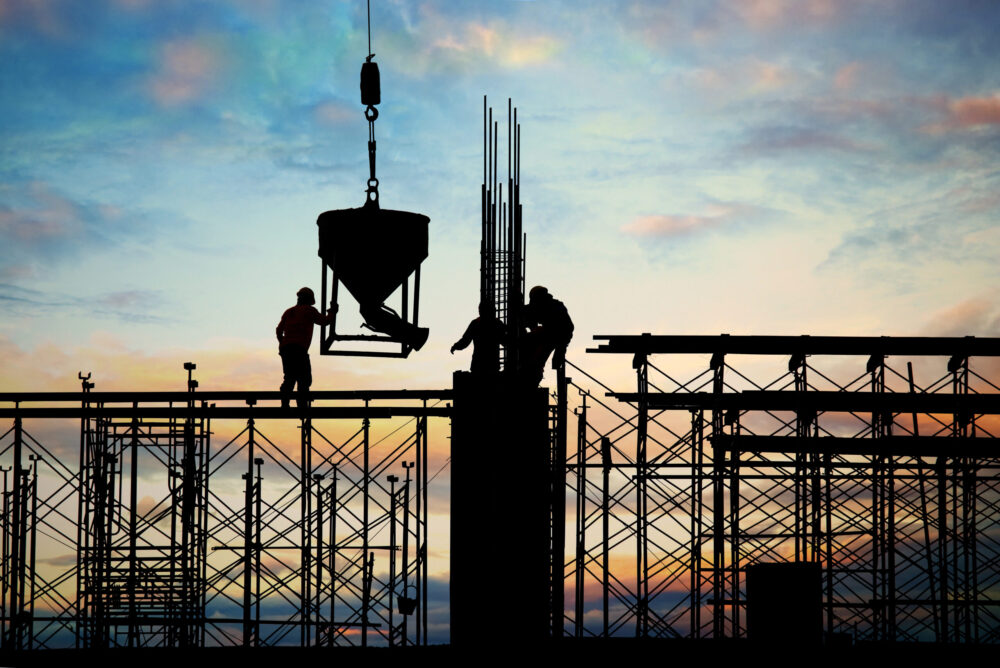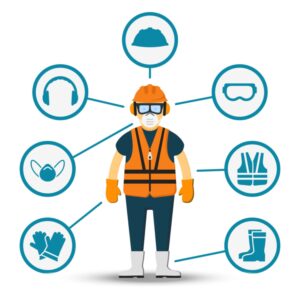
Being in the thick of construction season, it’s a good time to remind ourselves of some simple precautions that can ensure job site safety and avoid injuries. Safety violations in the workplace create a greater chance for injuries and OSHA involvement. Here are some construction job site safety tips that business owners and supervisors should go over with their crews:
- Safety Attire
- Toolbox Talks
- Common Construction Industry Problems
- Surface Safety
- Height Safety
- Underground Safety
- Notification System
Safety Attire

There are many different types of safety attire that can be worn on a construction site, depending on the job that needs to be done. Some common items of clothing include hard hats, safety glasses, gloves, high visibility vests, ear protection, masks, and steel-toed boots. Wearing the proper safety attire is essential in preventing injuries while working on a construction site.
What is a Toolbox Talk
Toolbox talks are a simple and cost-effective method for foremen or supervisors to supplement their company’s OSHA training efforts and keep safety at the forefront of their employees’ minds. These short pre-written safety sessions are meant to increase staff awareness of workplace hazards and OSHA rules.
How to Conduct a Toolbox Talk?
First, go here to download FREE provided toolbox talks for your company!
Toolbox talks are usually conducted at the beginning of a work shift but can be done any time there is a need to brief workers on a new hazard or safety issue. The talks should be short (no more than 15 minutes) and to the point. They can be done in person, via email, video conference, or by other means.
Common Construction Industry Problems
Before even arriving at a job site, it’s essential to ensure that your tools are safe for anyone to use. Never allow employees to use a tool that wasn’t intended for a task under any circumstance. Making sure your tools and equipment run properly will maximize your productivity and keep your job site safe.
2 Quick Checks That Save Hours
- All tools are loaded in the vehicle.
- You have enough batteries, chargers, and gas for the different tools.
These seem like no-brainers, right? You would NOT believe how many times companies get to a job site to find out that the batteries weren’t charged, or the impact wrench wasn’t in its case.
When tools are forgotten, crews try to rig something together. This dramatically increases the chance of an accident! If your commute to the job site is far away, it may make sense to go to a nearby parts store instead. However, trips to a parts store often lead to a ‘quick’ gas station stop, costing you time and money; especially if you don’t have an updated way to track employee time.
Here are some checks that will help prevent job site accidents and save you time and money, while not stopping progress during your work day.
Before Arriving At the Job site
- Check handles on all shovels, screwdrivers, & hammers; damaged handles lead to cuts that take time away from your work day.
- Make sure you have proper eye and ear protection.
- There are no deformities on any blades and that blade guard is attached.
- Ensure you have sharp blades.
- Make sure there are no exposed wires or damaged extension cords. Never use a cord that is hot or damaged in any way. Only use cords approved by a Nationally Recognized Testing Laboratory.
- Check fluid levels in all vehicles and equipment.
After Arriving At the Job site
- Don’t overload an extension cord or run them through any water or snow on the ground. Never cover an extension cord for a long period of time. Heat won’t be able to escape and this will create a fire hazard.
- Require high visibility vests on job sites where equipment is running.
- Never look away for any reason when operating a saw.
- Never disable safety guards or take out reverse warning alarms.
- Be alert of potentially dangerous situations on the job site.
Surface Safety
Another safety precaution to take into consideration is the surface you will be working on. Uneven surfaces can easily lead to slips, trips, and falls – which are some of the most common construction site injuries. It’s important to always be aware of your surroundings and plan each step accordingly.
Wet surfaces can also present a slipping hazard, so be sure to use caution when walking on any slippery surface. If possible, avoid working on wet surfaces altogether. Never place a ladder on wet, slippery, or uneven surfaces.
Check for cracks in the foundation and along trench lines. Always notify co-workers when new cracks appear and be ready to get to safe ground.
Height Safety
Whether a crew is working on a roof, changing a street light, or cutting down trees; always use the proper safety equipment. This includes wearing a harness and using a safety line. It is also important to be aware of your surroundings and to avoid working near edges or places that are easy to slip from.
Underground Safety
Make sure equipment operators understand and implement proper trenching techniques for the type of soil they are working in and that they follow OSHA guidelines. Cave-ins, falls, impact injuries, and the elements are common hazards when working in the trenches. Always be aware of moving objects, debris, trench cracks, and heat.
If a trench is to collapse, stay calm and call 911 immediately. Never attempt to dig the victim out with a machine. When a trench collapses, the weight of the material will displace the individual, making it impossible to know where their body is. Find additional information about what to do when a trench collapses here.
Trenching Safety Tips That Can Save A Life
Before excavating, call your local 811 agency to locate utilities. Always hand dig and expose lines within 2 ft before using a machine. If a trench is deeper than 20 ft, a protective system must be designed by an engineer. Here are the most common protective systems to prevent cave-ins from occurring:

– Sloping: Cut the trench wall at an angle to create a slope.
– Benching: You are creating steps down the trench line, one bench should never be deeper than 4ft.
– Shoring: Shoring is the process of bracing trench walls to prevent collapses. A sheet of plywood or metal is placed along the trench walls. Then, hydraulic pistons are pumped outward until they press up against the plate and wall firmly.
– Shielding: Shielding is using a trench box; Always use a trench box when digging more than 5 ft.
Notification System
Unfortunately, every precaution can be taken and accidents still happen! When this is the case, make sure your employees have instant access to report their injuries. busybusy, a mobile time tracking app that replaces paper time cards, comes with supervisor tools, job costing, and a universal map to see who’s working where. busybusy documents injury and non-injury reports daily. Documenting the health of your employees showing that there was no injury prevents false workers comp claims.
In Conclusion
Keeping your worksite safe requires a proactive and continuous effort from everyone on the job, and supervisors should set the example. By being aware of potential hazards, implementing safety protocols, and using the proper safety equipment, you can help create a safe environment for everyone. Try busybusy for FREE today and start tracking the safety of your employees and how they are using their time and equipment.











